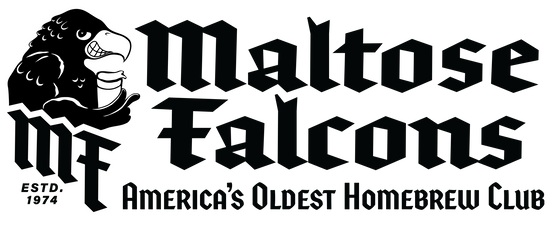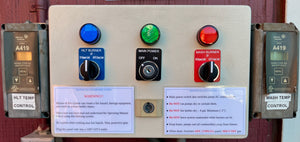Improved Club Brewing System
September 20, 2022
by Gavin Martin
The Falcons Brewing System has had a facelift in 2022. After a hiatus of two years due to the pandemic, when the rig was fired up for a Shop Brew in February this year, a few squawks were identified. Some of them were addressed before Lady Brew Day in May. A decision was then made to do an overhaul, which I offered to spearhead.
The improved system is ready to go, and will have its virgin run on the next Shop Brew, date TBD - we are waiting for the weather to cool off a bit.
For those of you who are not familiar with the system, it is a 1bbl (55 gal) 3-vessel HERMS system, put together by Kent “Fletch” Fletcher quite a few years ago. It is a single tier system which sits on a welded frame, and is direct fired by natural gas. It has a control panel that regulates kettle temperatures by automatically firing burners, This is done by using temp controllers to manage electronic gas valves.
Faulty equipment that was replaced included 2 pumps and the boil kettle banjo-style burner. We now have 2 new Riptide pumps and a new Hellfire burner.
Repairs/upgrades done included replacing a damaged HERMS coil, adding thermowells (previous sensors were directly immersed), adding a whirlpool return to the HLT, elevating the MT and BK stands, building custom pump caddies, and adding sensor quick disconnects. QD fittings were added on both pumps, and hose fittings were replaced with hi-flow QDs.
The control panel was totally redone, with all the wiring replaced. A main power key switch was added for safety. The face was sanded to remove rust, repainted, and re-labeled. There was one major control process change made, which has to do with the way mash temp is regulated.
Electric single vessel all-in-one systems are the rage right now, but when I became a home brewer and built my own rig 5 years ago, I went with the popular electric 3-vessel system at the time, which regulates mash temps by recirculating wort continuously using HERMS. I was intrigued to see the Falcons HERMS system used a very different process.
The HLT was maintained at a much higher temp than the mash (the manual recommended keeping the HLT at 190F), and the mash temp was regulated by the temp controller automatically starting and stopping the HERMS pump. It turns out that this was a popular “old-school” HE technique, which first evolved before the use of automated electronic gas valves or electric heaters. On the advice of Blichmann techs, and after talking with some members, I decided to remove this pump control and simplify the control system. On the last brew day, we were able to regulate mash temp within ± 1 degree by setting the HLT controller to mash temp +4°F while continuously recirculating.
Another feature of the system is the unconventional “Beanie” coil filter used in the mash tun in place of a false bottom. It was custom made by a club member (the eponymous Beanie) by separating the steel outer braid from salvaged telecom cable. In doing some research, I found a small company in Germany, MattMill, which has been making something similar for many years using spiral steel (like a long tightly-wound spring) instead of braided steel. It's called the Läuterhexe. Very recently, the Australian company Kegland - which has exploded on the US home brewing scene in recent years - has copied the exact spiral idea. Using a mash filter coil in a direct-fired kettle makes it extremely important to turn the mash burner off before doughing in, as grain sits on the kettle bottom. It would be interesting to compare efficiency of this coil vs. a false bottom - any member out there with a 55 gal Blichmann false bottom we can borrow?
We trust that this system will be handled with care, and hope that it will be a while before needing any more work. We have new mounted brackets to stow pumps and hoses indoors in order to prevent them from the damage they previously suffered from being stored outdoors.
I have created a new detailed Operating Guide, and urge brew crew members to familiarize themselves with it. We are also planning on making some instructional videos to supplement this guide. There is currently one done on pump cleaning and maintenance. Many thanks to Roger Taylor for his invaluable contribution in welding and adding a section to the frame. Also thanks to Craig Wickham for his efforts.
I encourage members to join a Shop Brew - it is a great way to share information and learn new techniques, while hanging out with folks sharing your passion - not to mention the free wort you could take home. We hope to see you at the next Shop Brew!
Update 10/20/22: I am happy to report that our new intrepid leader Rick Morales led a successful Shop Brew yesterday. He opted to mash with his personal Blichmann false bottom instead of the braided coil. An intermittent issue was identified with the MT burner, which will be fixed shortly.
Update 4/27/23: Here is a link to the Operation Guide and associated files.

